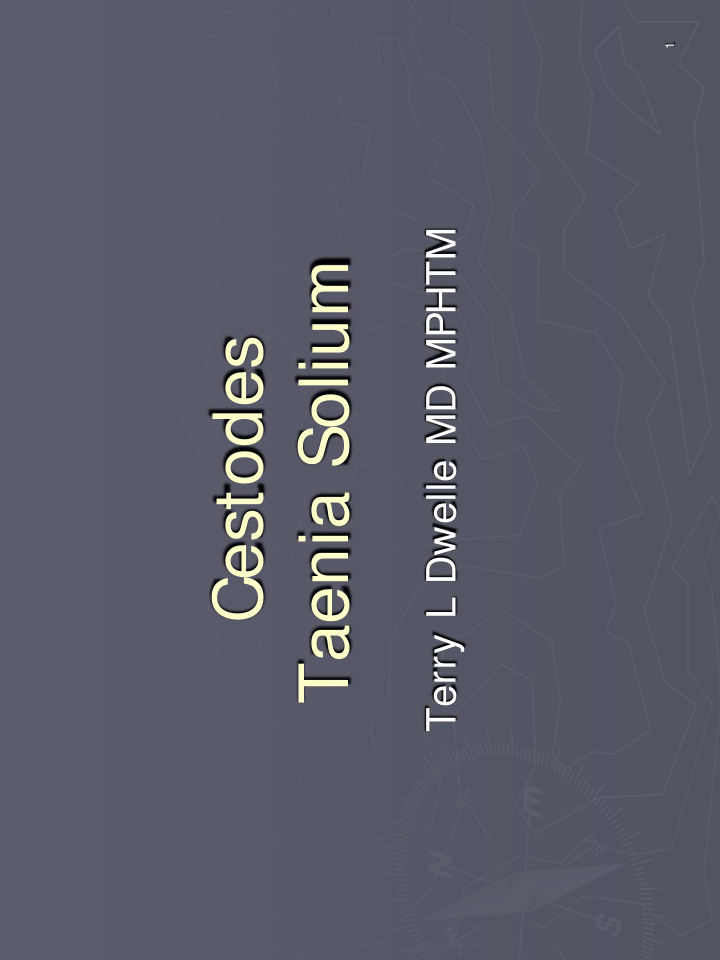



1 Terry L Dwelle MD MPHTM Taenia Solium Cestodes
Geographic Distribution ► Asia, Africa, the Philippines, South America, parts of Southern Europe and pockets of North America 2
General Recognition Features ► Size – Generally 3 meters or less ► Proglottids – less than 1000 3
General Recognition Features ► Scolex has four suckers with a rostellum that has a double circle of alternating large and small hooks (22-36) ► Proglottid is smaller than T saginata and has 7-13 lateral branches off the central uterus 4
5 T solium T sagninata
General Recognition Features ► Eggs � 31-43 um � Outer embryonal membrane � Brown shell � Embryo 6
7 Embryonal membrane Embryo Brown shell
General Recognition Features ► Cysticercus � 5-10 mm � In muscle of pork � Invaginated scolex � Scolex exvaginates and breaks off when digested out of the muscle 8
9 Cysticercus Hooks
Life Cycle ► Definitive host – man ► Stage leaving the body – gravid proglottids, occasional embryonated eggs ► Intermediate host – pigs and man ► Infectious stage for the definitive host – infectious eggs for cysticercosis, cysticerci for tapeworm infection 10
Life Cycle Infected tissue eaten by man Cysticerus stage develops in tissue Cysticercus digested (infectious for 1 year) out of infected tissue 2-3 months Scolex exvaginates Embryo passes to tissue via and attaches to mesenteric venules or small intestine lymphatics 10-12 weeks Gravid proglottid Eggs hatch in duodenum segments found in feces 5-12 weeks Eggs or proglottids eaten by cattle or Eggs extruded man Infectious for 2-6 months 11
Life Cycle ► Prepatent period – 5-12 weeks ► Patent period – decades ► 3 routes of egg ingestion � Heteroinfection - contaminated food and water � External autoinfection – perineal skin to mouth � Internal autoinfection – regurgitation proglottids to stomach 12
Transmission ► Eating of inadequately cooked pork ► Contaminated food and water ► Use of raw human sewage for agriculture ► Inadequate human fecal sanitation 13
14 Cysticerci
Pathogenicity ► Cysticercosis – encapsulation occurs around the cysticercus except in the eye or brain 15
Disease ► Tapeworm � Generally asymptomatic except for passage of proglottids � End of prepatent period – diarrhea and abdominal pain in ½ of the cases � Rare – intestinal obstruction 16
Disease ► Cysticercosis � Major – CNS, muscle, SQ tissues and eye � Other – lung, heart, liver, other viscera � CNS – Seizures, stroke, hydrocephalus, headache, nausea and vomiting, dizziness, diplopia, psychiatric problems, meningoencephalitis, visual loss, CSF (elevated protein, low glucose, increased cells) � Eye – Shadows, uveitis, iritis, retinal detachment, atrophy of the choroid, conjunctival encapsulation � Mortality – 25-65% in neurocysticercosis 17
18
Cysticercosis ► Morbidity is almost entirely due to CNS disease ► Prevalence of CNS disease is up to 2% in endemic areas. Many are asymptomatic clinically. Found on autopsy. ► It may take years from onset of infection to onset of symptoms 19
20 Cysticerci bubble Cysticerci
Laboratory Diagnosis ► Clinical suspicion ► Cysticerci identified � Excised nodules or surgical specimens � Mobile larvae seen in the eye � Brain imaging (eg CAT scan, radiographs of muscle) � Serology – ELISA (80% even in endemic areas). The � enzyme immunotransfer blot assay is likely the antibody test of choice. � Antigen detection in CSF and Blood ► Eggs identified ► Proglottids identified 21
Imaging ► Calcified lesions ► Small hypodense areas (< 2 cm) often (1/2 time) can have a central bright spot (scolex) ► Disc enhancement or ring around hypodense areas is associated with spontaneous resolution from the CT in 12 months ► Occasionally can see large cysts (6 cm). Must differentiate from hydatid disease, coenurosis or racemose cysticercosis 22
23 Cysts
Treatment of Tapeworm Medication Adult Pediatric Praziquantel 5-10 mg/kg 5-10 mg/kg once once Niclosamide 2 gm once 50 mg/kg once 24
Adverse Medication Reactions ► Praziquantel (Biltricide – Bayer) � Frequent: abdominal pain, diarrhea, malaise, headache, dizziness � Occasional: neutropenia, GI disturbance, methemoglobinemia � Rare: CNS symptoms, hypertension, arrhythmias 25
Adverse Medication Reactions ► Niclosamide � Occasional – abdominal pain, anorexia, diarrhea, emesis � Rare – dizziness, skin rash, drowsiness, perianal itching, unpleasant taste 26
Treatment of Cysticercosis Medication Adult Pediatric Albendazole 400 mg bid X 8- 15 mg/kg/d 30d (can be (max 800 mg) in repeated) 2 doses X 8-30 d (can be repeated) Praziquantel 50-100 mg/kg/d 50-100 mg/kg/d in 3 doses X 30d in 3 doses X 30d 27
Cysticercosis Treatment ► Initial therapy for single inflammed parenchymal cysticercosis or with calcified lesions – Rx seizures with anti-seizure medication ► Use of albendazole or praziquantel for parenchymal cysticercosis without seizures is controversial (JM Mcguire NEJM 2004;350:215) ► Patients with live parenchymal cysts who have seizures should be treated with albendazole + steroids (6 mg dexamethasone or 40-60 mg prednisone / day) (Garcia NEJM 2004:350:249) ► Patients with subarcahnoid cysts or giant cysts in the fissures treat for at least 30 days (Proano, NEJM 2001:345:879) ► Surgical intervention or shunting is indicated for hydrocephalus. Give 40 mg prednisone with the surgery. ► Arachnoiditis, vasculitis or cerebral edema – treat with prednisone 60 mg/d or dexamethasone 4-6 mg/d + albendazole or praziquantel (AC White Annu Rev Med 2000:51-187) ► Any cysticeroidicidal drug may cause irreparable damage when used to treat ocular or spinal cysts even when given with steroids. An opthalmologic examination should always precede treatment to r/o introcular cysts. The Medical Letter, August, 2004 28
Cysticercosis Treatment ► Ocular and spinal cysts – treated with surgery 29
Adverse Medication Reactions ► Albendazole � Occasional: diarrhea, abdominal pain � Rare: leukopenia, alopecia, increased serum transaminase levels 30
31 Cerebrospinal fluid
Control Measures ► Prompt treatment of tapeworm infected humans ► Sanitary disposal of human feces ► Adequate meat inspection ► Cooking beef to > 65C or freezing at -20C for 24 hours ► Stool examination of food handlers from endemic countries ► Avoid eating uncooked vegetables and fruits that cannot be peeled while traveling in developing countries 32
Recommend
More recommend